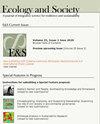阿根廷大西洋森林的移民社区用药用植物塑造花园景观
IF 3.2
2区 社会学
Q1 ECOLOGY
引用次数: 0
摘要
移民的家庭花园可以从新旧景观的元素中创造出来。我们假设移民花园中的药用植物组合受到植物多样性和可用性、治疗需求和遗传过程的影响。哪个因素占上风:与生物多样性和生态有关的因素,与流行病学有关的因素,还是与遗产和记忆有关的因素?在本文中,我们提供了关于全球南方园林景观的新知识。这项研究是在阿根廷的大西洋森林进行的。我们调查了120个家庭花园:60个是巴拉圭越境移民,60个是二战前抵达阿根廷米西奥内斯的跨大陆欧洲人及其后代。考虑到日常尺度和跨国尺度,我们比较了这些群体之间园林植物的丰富程度、组成、药用用途和关系(通过植物网络)。巴拉圭人培育和保护了137种植物,主要是本地植物,欧洲人培育和保护了119种,本地和外来的比例相似。移民群体在植物成分上的相似性(68%)和药用上的一致性(62%)很高。植物网络分析揭示了植物组合中的许多重叠,但由于文化表达和治疗需求,每个群体的某些特殊性仍然存在。这种高度的相似性表明,植物多样性,无论是本地的还是外来的,都有共同的疾病概念,这些群体之间的知识流动在塑造家庭花园药用植物组合方面比遗产化实践更重要。巴拉圭和欧洲血统的人没有积极努力把他们的家庭花园变成遗产。药用植物与生活场所——亲密的日常实践——有关,而不是与种族认同策略有关。然而,花园中的植物组合受到生态、殖民遗产、怀旧和知识转移的影响;因此,移民的家庭花园可以被认为是广义上的遗产。本文章由计算机程序翻译,如有差异,请以英文原文为准。
Shaping garden landscape with medicinal plants by migrant communities in the Atlantic Forest, Argentina
Migrants’ home gardens may be created from elements of both old and new landscapes. We assume that medicinal plant assemblages in migrants’ gardens are shaped by plant diversity and availability, therapeutic needs, and heritagization processes. Which of the factors prevail: those related to biodiversity and ecology, epidemiology, or heritage and memory? In this paper we offer new knowledge on the garden landscapes of the Global South. The research was conducted in the Atlantic Forest in Argentina. We surveyed 120 home gardens: 60 of transborder Paraguayan migrants, and 60 of transcontinental Europeans who arrived in Misiones, Argentina before WW2 and their descendants. We compared the richness, composition, medicinal uses, and the relationships of garden plants (via plant networks) between these groups, taking into account everyday scales and the transnational scale. Paraguayans cultivated and protected 137 species, predominantly native, and people of European origin 119 spp., native and exotic in similar proportions. The similarity in plant composition (68%) and the consensus in the medicinal use of plants (62%) were high between the migrant groups. Plant network analysis revealed many overlaps in assemblages of plants, but certain particularities of each group remained because of cultural expressions and therapeutic needs. This high level of similarity suggests that plant diversity, both native and allochthonous, shared concepts of illness, and the flux of knowledge between these groups was more significant than heritagization practices in shaping home gardens’ medicinal plant assemblages. People of Paraguayan and European origins do not make an active effort to convert their home gardens into heritage. Medicinal plants are connected to the lived emplacement—intimate daily practices—rather than to ethnic identity strategies. Nevertheless, the plant assemblages in gardens have been shaped by ecology, colonial legacy, nostalgia, and transfer of knowledge; therefore migrants’ home gardens can be considered heritage in a broad sense.
求助全文
通过发布文献求助,成功后即可免费获取论文全文。
去求助
来源期刊

Ecology and Society
环境科学-生态学
CiteScore
6.20
自引率
4.90%
发文量
109
审稿时长
3 months
期刊介绍:
Ecology and Society is an electronic, peer-reviewed, multi-disciplinary journal devoted to the rapid dissemination of current research. Manuscript submission, peer review, and publication are all handled on the Internet. Software developed for the journal automates all clerical steps during peer review, facilitates a double-blind peer review process, and allows authors and editors to follow the progress of peer review on the Internet. As articles are accepted, they are published in an "Issue in Progress." At four month intervals the Issue-in-Progress is declared a New Issue, and subscribers receive the Table of Contents of the issue via email. Our turn-around time (submission to publication) averages around 350 days.
We encourage publication of special features. Special features are comprised of a set of manuscripts that address a single theme, and include an introductory and summary manuscript. The individual contributions are published in regular issues, and the special feature manuscripts are linked through a table of contents and announced on the journal''s main page.
The journal seeks papers that are novel, integrative and written in a way that is accessible to a wide audience that includes an array of disciplines from the natural sciences, social sciences, and the humanities concerned with the relationship between society and the life-supporting ecosystems on which human wellbeing ultimately depends.
 求助内容:
求助内容: 应助结果提醒方式:
应助结果提醒方式:


